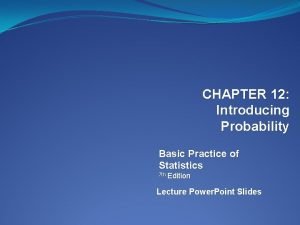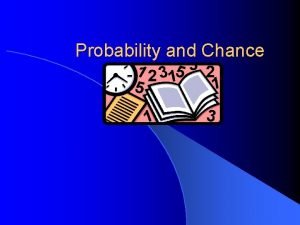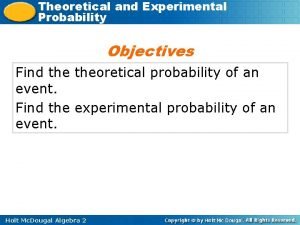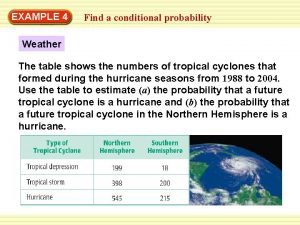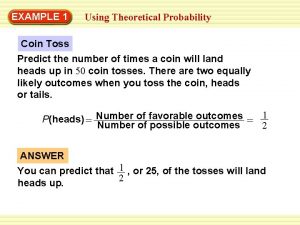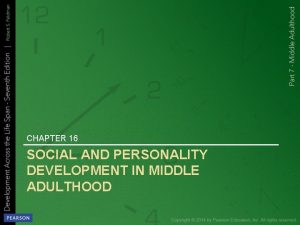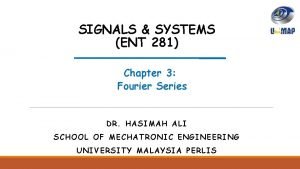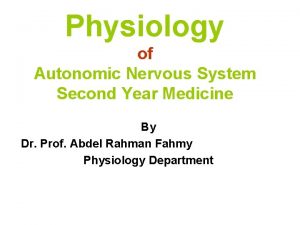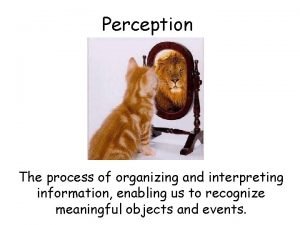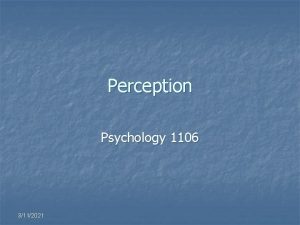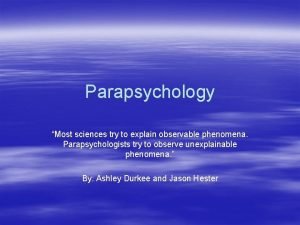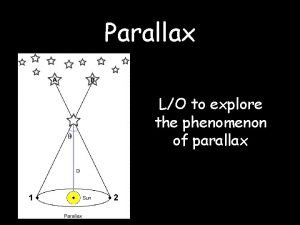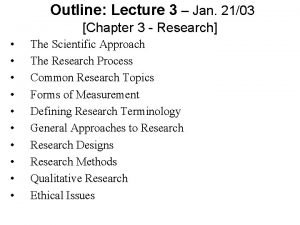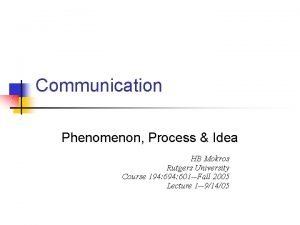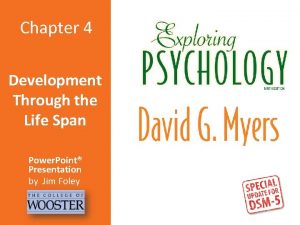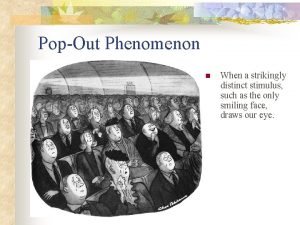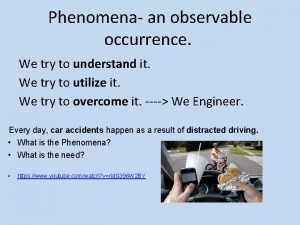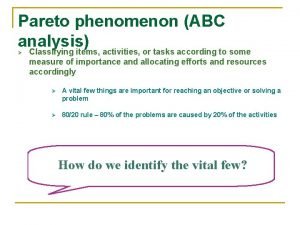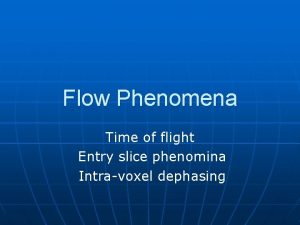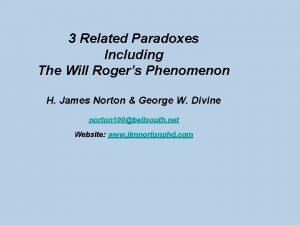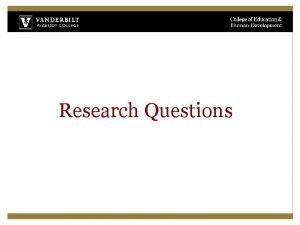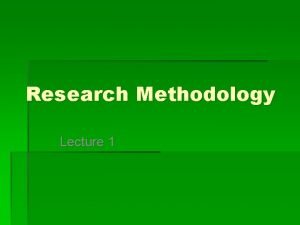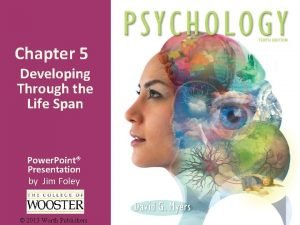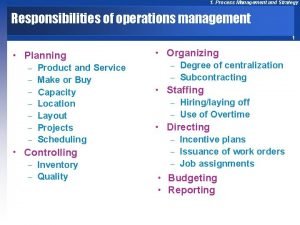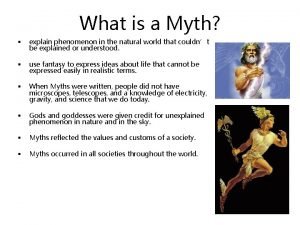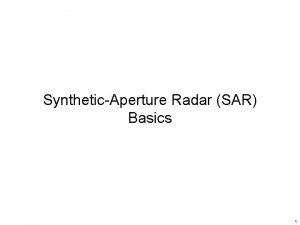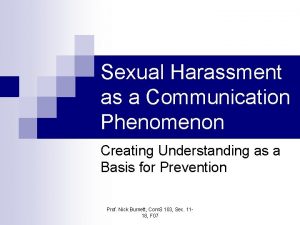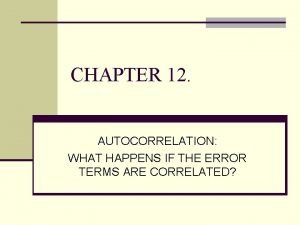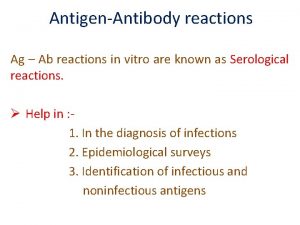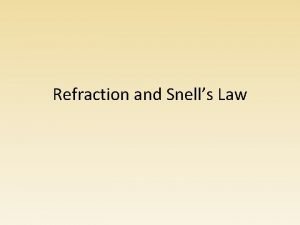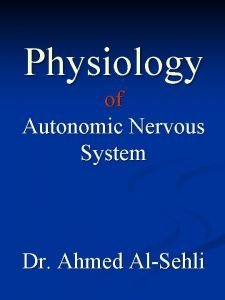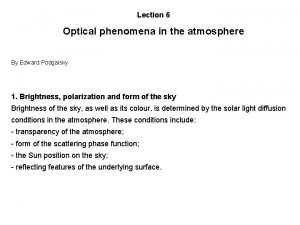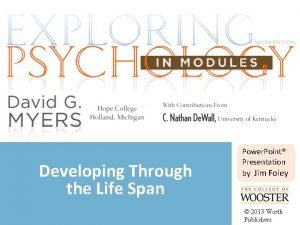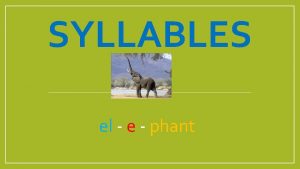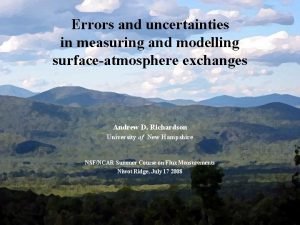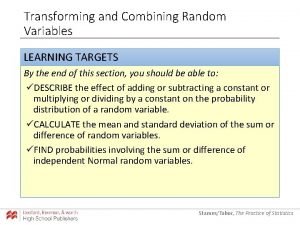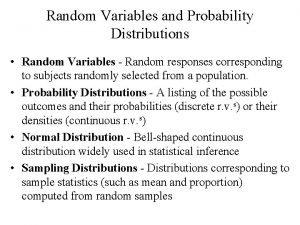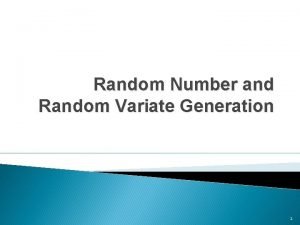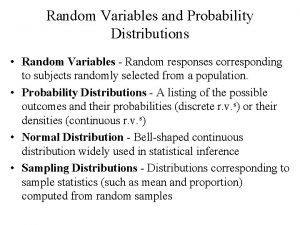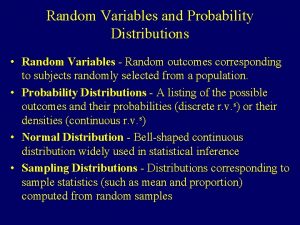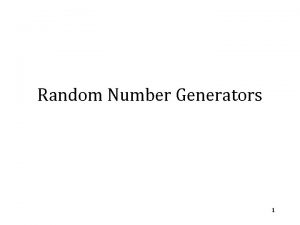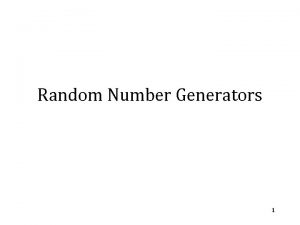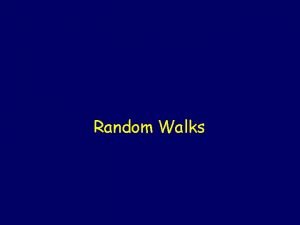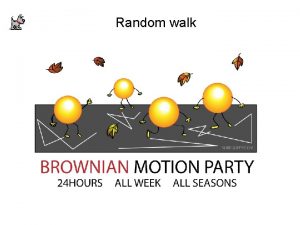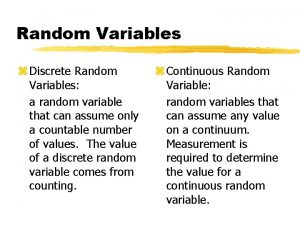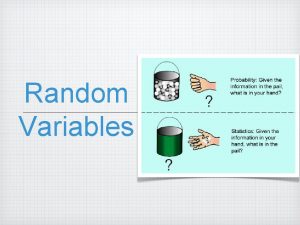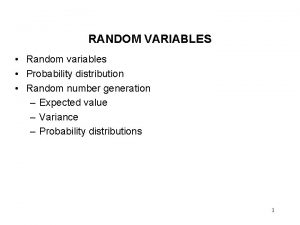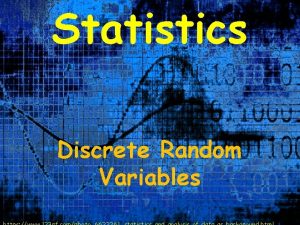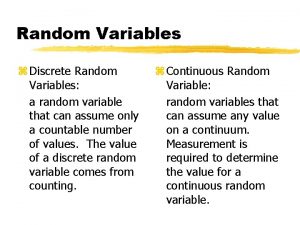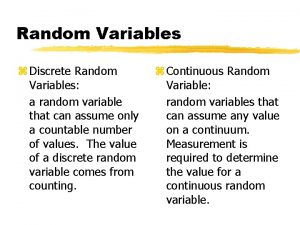Experiment and random phenomenon An experiment is any















































































































- Slides: 111

Experiment and random phenomenon 定 義 • An experiment is any activity from which an outcome, measurement, or result is obtained. 任何求結果的過程或活動皆 可稱為「試驗」。 • When the outcomes cannot be predicted with certainty, the experiment is a random experiment. 社會統計(上) 2007 1


Example of Experiments 實 例 • 試驗: – Measuring the lifetime (time to failure) of a given product – Inspecting an item to determine whether it is defective – 丟銅板 • 隨機現象: – 生男生女 – 革命或政變的發生 社會統計(上) 2007 3




Basic Outcomes and Sample Space 定 義 • The set of all possible basic outcomes for a given experiment (random phenomenon) is called the sample space. 隨機現象的所有可能 結果稱為樣本空間,一般以S或Ω表示。 • Each possible outcome of a random experiment is called a basic outcome (or a sample point, an element in the sample space). 隨機實驗中所得 到的任何可能的個別結果稱之為「基本結果 」(或樣本點、或簡稱樣本),以小寫oi表示。 社會統計(上) 2007 7








Assigning Probabilities to Events 事件的機率 定 義 • There are two types of random experiments, those that can be repeated over and over again under essentially identical conditions and those that are unique and cannot be repeated. 社會統計(上) 2007 15

Assigning Probabilities to Events 事件的機率 定 義 • A numerical measure that indicates the likelihood of a specific outcome in a repeatable random experiment is called an objective probability, whereas the probability associated with a specific outcome of a unique and nonrepeatable random experiment is called a subjective probability. 社會統計(上) 2007 16

Assigning Probabilities to Events 事件的機率 定 義 • There are three different approaches to assigning probabilities to basic outcomes: • 1. The relative frequency approach • 2. The equally likely approach • 3. The subjective approach 社會統計(上) 2007 17

The Relative Frequency Approach 相對次數(後天)機率理論 定 義 • Let f. A be the number of occurrences, or frequency of occurrence, of event A in n repeated identical trials. The probability that A occurs is the limit of the ratio f. A/n as the number of trials n becomes infinitely large. 社會統計(上) 2007 18


後天機率理論的缺陷 定 義 • (1) Because we can never replicate an experiment an infinite number of times, it is impossible to determine the limit of the ratio f. A/n as n approaches infinity. • (2) We can never be sure that we have repeated an experiment under identical conditions. 社會統計(上) 2007 20

後天機率理論的缺陷 定 義 • When we use the relative frequency approach, we use the observed ratio f. A/n to approximate theoretical probability that event A occurs. That is, we assume that P(A) f. A/n when n is sufficiently large. 社會統計(上) 2007 21

The Equally Likely Approach 古典(先天)機率理論 定 義 • Suppose that an experiment must result in one of n equally likely outcomes. Then each possible basic outcome is considered to have probability 1/n of occurring on any replication of the experiment. • 一樣本空間有n個樣本點(基本結果),且每一 個樣本點發生的機會皆相等。則在任何重複試 驗中,每一個樣本點發生的機率為 1/n。若事件 A的樣本點個數為n. A,則A發生的機率為: • P(A) = n. A/n,符合某條件結果的個數與總結果 數之比。 社會統計(上) 2007 22


Objective Probability客觀機率 定 義 • A probability obtained by using a relative frequency approach or an equally likely approach is called an objective probability. 社會統計(上) 2007 24



Which approach is best? • The nature of the problem determines which approach is best. • Problems with an underlying symmetry, such as coin, dice, and card problems, are especially suited to the equally likely approach. • Problems for which we have large samples of data based on many replications of an experiment are especially suited to the relative frequency approach. • Problems that occur only once, such as a sporting event, are especially suited to the subjective 社會統計(上) 27 2007 approach. 定 義


Set Theory 定 義 • Subset子集合 • An event A is contained in another event B if every outcome that belongs to the subset defining the event A also belongs to the subset defining the event B. • A = {2, 4, 6} B={2, 3, 4, 5, 6} • A B, A is a subset of B • If A B and B A, then A = B • If A B and B C, then A C • Empty Set or Null Set空集合Ø • For any event A, Ø A S, 社會統計(上) 2007 29

Operation of Set Theory: Unions聯集 S • Unions聯集 • Let A and B be two events in the sample space S. Their union, denoted A U B. is the event composed of all basic outcomes in S that belong to at least one of the two events A or B. Hence, the union A U B occurs if either A or B (or both) occurs. 社會統計(上) 2007 A 定 義 B 30

Operation of Set Theory: Unions聯集 • Unions聯集: The union of n S events A 1, A 2, …, An is defined to be the event that contains all outcomes which belong to at least one of these n events. 社會統計(上) 2007 A 定 義 B 31

Operation of Set Theory: Intersection交集 • Intersection交集: • Let A and B be two events in the sample space S. The intersection of A and B, denoted A B. is the event composed of all basic outcomes in S that belong to both A and B. Hence, the intersection A B occurs if both A and B occur. 社會統計(上) 2007 S A 定 義 B 32

Operation of Set Theory: Intersection交集 • Intersection交集: • The intersection of n events, A 1, …An is defined to be the event that contains the outcomes which are common to all these n events. 社會統計(上) 2007 S A 定 義 B 33

Complement of an Event 定 義 • Let A denote some event in the sample space S. The complement of A (A的餘事件), denoted by Ac, represents the event composed of all basic outcomes in S that do not belong to A. S A Ac 社會統計(上) 2007 34

Complement has the following properties: • • • (Ac)c =A A Ac = S Øc = S Sc = Ø A Ac = Ø S A 社會統計(上) 2007 定 義 Ac 35

Complement has the following properties: • (A ∪ B)c =Ac ∩Bc • (A ∩ B)c =Ac ∪ Bc S B 定 義 Bc A Ac • P(A) = P(A ∩ B) +P(A ∩ Bc) • P(Ac ∩ Bc) = 1 - P(A ∪ B) • P(Ac ∪ Bc) = 1 - P(A ∩ B) 社會統計(上) 2007 36

Mutually Exclusive Events (Disjoint Events) • Let A and B be two events in a sample space S. If A and B have no basic outcomes in common, then they are said to be mutually exclusive. If A and B are mutually exclusive events, we write (A B) = Ø, where Ø denotes the empty set. P(A B) = 0. 社會統計(上) 2007 37

Some basic rules of probability 定 義 • Probability of a basic outcome: • For each basic outcome oi, 0 P(oi) 1. • Probability of an event: • Let event A = { o 1 , o 2 , o 3 , o 4 , o 5 , …ok }, where o 1 , o 2 , o 3 , o 4 , o 5 , …ok are k different basic outcomes. The probability of any event A is the sum of the probabilities of the basic outcomes in A. That is, • P(A) = P(o 1) + P(o 2) + P(o 3) + P(o 4) + P(o 5) +…+P(ok) = AP(oi) • where AP(oi) means to obtain the sum over all basic outcomes in event A. 社會統計(上) 2007 38

Some basic rules of probability 定 義 • Rule 1. 所有機率的數值皆介於 0與1之間: – For each basic outcome oi, 0 P(oi) 1. – The probability of P(A) satisfies 0 P(A) 1. • Rule 2. 將所有的可能發生的結果的機率加總必 等於一: – Let event S = { o 1 , o 2 , o 3 , o 4 , o 5 , …on } represent the sample space of an experiment. The probability of S is P(S) = s. P(oi) = 1 • Rule 3. 一個事件不發生的機率等於 1減去發生的 機率: – P(Ac) = 1 - P(A) • Rule 4. 如果兩事件沒有共同的結果,兩事件發 生的總和機率為個別機率的和: – If A and B are disjoint: P(A or B) = P(A) + P(B) 社會統計(上) 2007 39

Definition of Probability • Axiom 1公理1: For any event A, P(A) 0事件A發生的機率為實數 • Axiom 2: P(S) = 1. • Axiom 3: For any infinite sequence of disjoint events (互斥事件) A 1, A 2, … 社會統計(上) 2007 40

Definition of Probability • A probability distribution , or simply a probability, on a sample space S is a specification of numbers P(A) which satisfy Axioms 1, 2, and 3. • 設有一試驗其樣本空間為S,對S中之 任一事件A指定一值P(A),若P(. )滿足 上述三個公理,則稱P(. )為一機率測 度,且稱P(A) 為事件A的機率。 社會統計(上) 2007 41


Theorem 2: • For any finite sequence of n disjoint events A 1, A 2, …, An 與公理3 的不同處 社會統計(上) 2007 43


Theorem 3: 餘事件的機率 Probability of the complement of an event 定 義 • Let Ac denote the complement of A. Then P(Ac) = 1 – P(A). • Proof: • Since A and Ac are disjoint events and A Ac = S, • it follows from Theorem 2 that P(S) = P(A) + P(Ac). • Since P(S) =1 by Axiom 2, • then P(Ac) = 1 – P(A). 社會統計(上) 2007 45


Theorem 5 • • • If A B, then P(A) ≦ P(B) Proof. B = A BAc P(B) = P(A) P(BAc ) ≧ 0 P(A) ≦ P(B) 社會統計(上) 2007 定 義 B BAc A 47

Theorem 6: • P(A B) = P(A) + P(B) – P(AB) • Proof: • P(A B) = P(ABc) + P(AB) + P(Ac. B) • P(A) = P(ABc) + P(AB) A • P(B) = P(Ac. B)+ P(AB) ABC 社會統計(上) 2007 AB B AC B 48


例題 • Suppose that 15% of the freshmen fail chemistry, • 12% fail math, • and 5% fail both. • Suppose a first‑year student is picked at random. Find the probability that the student failed at least one of the courses. • P(A B) = P(A) + P(B) – P(AB) • =. 15 +. 12 -. 05 =. 22 社會統計(上) 2007 50




Joint Probability Tables 聯合機率表 row sum column sum 社會統計(上) 2007 54

Joint Probability Tables 聯合機率表 男生且被拒絕 的機率= 4700/12500 =. 376 A joint probability shows the probability that an observation will possess two (or more) characteristics simultaneously. Every joint probability must be a number in the closed interval [0, 1] and the sum of all joint probabilities must be 1. 社會統計(上) 2007 55



Conditional Probability 條件機率 定 義 • P(A B) : The probability that some event A occurs given that some other event B has already occurred. • If the probability of one event varies depending on whether a second event has occurred, the two events are said to be dependent. 社會統計(上) 2007 58





Conditional Probability 社會統計(上) 2007 63

Conditional Probability 社會統計(上) 2007 64


Multiplicative law of probability S 社會統計(上) 2007 A 定 義 B 66












Independence獨立 定 義 • Theorem: If two events A and B are independent, then the events A and Bc are also independent. S • Proof. A B ∵ A and B are independent 社會統計(上) 2007 78

Independence獨立 例 題 • Approximately 30% of the sales representatives hired by a firm quit in less than 1 year. Suppose that two sales representatives are hired and assume that the first sales representative's behavior is independent of the second sales representative's behavior. • (a) What is the probability that both quit within a year? • (b) Find the probability that exactly one representative quits. 社會統計(上) 2007 79

Independence獨立 例 題 • (a) What is the probability that both quit within a year? • (b) Find the probability that exactly one representative quits. 社會統計(上) 2007 80

Tree Diagrams. 3 A. 3. 7 Ac. 3. 7 B Bc 社會統計(上) 2007 例 題 81


Sampling with and without replacement 概 念 Selecting a random sample can be viewed as a process in which we sequentially obtain one observation after another. When we sample with replacement, successive outcomes are independent: When we sample without replacement, successive outcomes are not independent: 社會統計(上) 2007 83



樣本空間分割 定 義 The sample space of an experiment is partitioned into k mutually exclusive and exhaustive events A 1, A 2, … Ak 若A 1, A 2, … Ak為樣本空間S的部分集合,且滿足 下列條件: 1. A 1∪A 2 ∪A 3… ∪Ak= S 2. Ai∩Aj = 則稱{A 1, A 2, … Ak}為樣本空間S的一分割 (partition) 社會統計(上) 2007 86





Bayes’ Theorem貝氏定理 Posterior probability Prior probability 事後機率 事前機率 社會統計(上) 2007 定 義 91





Tree Diagrams. 98 D 1有病. 02. 003. 997 D 2健康 . 01 . 99 A 1陽 (. 00294)/(. 00294+. 00997) =. 2277 A 2陰 A 1陽 A 2陰 社會統計(上) 2007 例 題 96


Tree Diagrams. 02 E 1. 4. 6 E 2 A (. 008)/(. 008+. 018) =. 308 . 98. 03 . 97 Ac A Ac 社會統計(上) 2007 例 題 98



Factorial Notation 概 念 • 令N 為一正整數. • The product of all integers from 1 to N is called N factorial and is denoted N!: N!=N(N-1)(N-2)…(3)(2)(1) We define 0! = 1 社會統計(上) 2007 101

Permutation排列 概 念 • A permutation of N different things taken R at a time, denoted NPR or PN, R is an arrangement in a specific order of any R of the N things. 社會統計(上) 2007 102

Permutation排列 • N P 3 N N-1 n 2 社會統計(上) 2007 概 念 N-2 n 3 103

Permutation排列 社會統計(上) 2007 104






Number of possible sample • The number of possible samples of size n from a population of size N is CN, n • 蘇老師想要從全班 50名同學中抽取 5位 同學來詢問上課反應,請問共有多少 種可能的樣本? • C 50, 5=2, 118, 760 社會統計(上) 2007 110

EXCEL function • PN, R • PERMUT(N, R) • NC R • COMBIN(N, R) 社會統計(上) 2007 111
 In probability and statistics a random phenomenon is
In probability and statistics a random phenomenon is Random assignment vs random sampling
Random assignment vs random sampling Random assignment vs random selection
Random assignment vs random selection There aren't any carrots
There aren't any carrots Any to any connectivity
Any to any connectivity Any question atau any questions
Any question atau any questions Random experiment
Random experiment Experimental vs theoretical probability
Experimental vs theoretical probability Gof matlab
Gof matlab What is random experiment
What is random experiment Theoretical probability of tossing a coin
Theoretical probability of tossing a coin μπεχνάζ ανσαρί
μπεχνάζ ανσαρί Levinson seasons of life theory
Levinson seasons of life theory Teoryang interference phenomenon at interlanguage
Teoryang interference phenomenon at interlanguage Adsorption phenomenon
Adsorption phenomenon Foot-in-the-door psychology example
Foot-in-the-door psychology example Fourier series trigonometric form
Fourier series trigonometric form Hanau's quint
Hanau's quint Orbelli phenomenon
Orbelli phenomenon Adsorption
Adsorption Binocular cues
Binocular cues Perceptual set psychology definition
Perceptual set psychology definition Brightness constancy ap psychology
Brightness constancy ap psychology Observable phenomenon
Observable phenomenon Phenomenon of parallax
Phenomenon of parallax Phenomenon of interest in research
Phenomenon of interest in research Reference phenomena in nlp
Reference phenomena in nlp Reference phenomena in nlp
Reference phenomena in nlp What is staircase phenomenon
What is staircase phenomenon Source monitoring error
Source monitoring error Billiard ball ricochet effect
Billiard ball ricochet effect Keyhole phenomenon
Keyhole phenomenon Iceberg phenomenon disease
Iceberg phenomenon disease Defination of hypersensitivity
Defination of hypersensitivity Gravitation is a natural phenomenon where:
Gravitation is a natural phenomenon where: Globalization phenomenon
Globalization phenomenon Normal qrs interval
Normal qrs interval What is implied
What is implied Recall vs recognition
Recall vs recognition Dawn phenomenon
Dawn phenomenon Communication phenomenon
Communication phenomenon Arc phenomenon in circuit breaker
Arc phenomenon in circuit breaker Death deferral theory psychology
Death deferral theory psychology What phenomenon is created by two tuning forks
What phenomenon is created by two tuning forks Central.route persuasion
Central.route persuasion Phenomenon syllables
Phenomenon syllables Pop out phenomenon
Pop out phenomenon Observable phenomena meaning
Observable phenomena meaning Pareto phenomenon in operations management
Pareto phenomenon in operations management Volcano formation
Volcano formation The phenomenon of magnetism is best understood in terms of
The phenomenon of magnetism is best understood in terms of Entry slice phenomenon mri
Entry slice phenomenon mri Investigative phenomenon
Investigative phenomenon The phenomenon of diffraction can be understood using *
The phenomenon of diffraction can be understood using * Icarus and daedalus analysis
Icarus and daedalus analysis Objective style
Objective style Anchor phenomena
Anchor phenomena Rollover phenomenon in acoustic neuroma
Rollover phenomenon in acoustic neuroma Will rogers phenomenon definition
Will rogers phenomenon definition Self fulfilling prophecy example
Self fulfilling prophecy example Bevelling phenomenon
Bevelling phenomenon Door in the face phenomenon
Door in the face phenomenon Door in the face phenomenon
Door in the face phenomenon Non researchable problem
Non researchable problem Process of research definition
Process of research definition Contemporary phenomenon examples
Contemporary phenomenon examples No significant difference phenomenon
No significant difference phenomenon Fenomena
Fenomena Representasi suatu fenomena
Representasi suatu fenomena Non balanced occlusion
Non balanced occlusion Death deferral phenomenon
Death deferral phenomenon European union definition ap human geography
European union definition ap human geography Door in the face phenomenon
Door in the face phenomenon Pareto phenomenon in operations management
Pareto phenomenon in operations management Explain phenomenon
Explain phenomenon Spatial outline
Spatial outline Communication phenomenon
Communication phenomenon Dilatant flow
Dilatant flow What is red tide phenomenon
What is red tide phenomenon Robinhood phenomenon
Robinhood phenomenon Yielding phenomenon
Yielding phenomenon Marketing analytics: strategic models and metrics
Marketing analytics: strategic models and metrics Explain arc phenomenon
Explain arc phenomenon Positive autocorrelation
Positive autocorrelation Brain drain phenomenon
Brain drain phenomenon Eaton-rosen phenomenon
Eaton-rosen phenomenon Postzone phenomenon
Postzone phenomenon What is this phenomenon known as
What is this phenomenon known as Wolff chaikoff effect
Wolff chaikoff effect T3 thyrotoxicosis causes
T3 thyrotoxicosis causes Crankshaft phenomenon
Crankshaft phenomenon A moose monikko
A moose monikko Staircase phenomenon
Staircase phenomenon Refract light
Refract light Radioactivity phenomenon
Radioactivity phenomenon Staircase phenomenon
Staircase phenomenon Cross bridge myosin head
Cross bridge myosin head Ganglion meaning
Ganglion meaning Treppe
Treppe Phenomenon aka 6
Phenomenon aka 6 Which of the following explains this phenomenon?
Which of the following explains this phenomenon? Death-deferral phenomenon
Death-deferral phenomenon The arrangement of a phenomenon across earth's surface is
The arrangement of a phenomenon across earth's surface is Elephant syllables split
Elephant syllables split Prozone phenomenon in brucellosis
Prozone phenomenon in brucellosis Kahoot pin
Kahoot pin Random latitude longitude
Random latitude longitude Random scan system
Random scan system Random access file organization
Random access file organization What is random error
What is random error Transforming random variables
Transforming random variables Simple random sampling pros and cons
Simple random sampling pros and cons
